Muckhart
Muckhart (Scottish Gaelic: Muc-Àird) commonly refers to two small villages in Clackmannanshire, Scotland, Pool of Muckhart (Scottish Gaelic: Poll Mhuc-Àird) and Yetts o' Muckhart. Muckhart is one of the Hillfoots Villages, situated on the A91 around 3 miles north-east of Dollar. The Gaelic name, Muc-àird, comes from 'muc' (Pig) + 'àird' (Height), and may derive from the fact that the surrounding fields may once have been used for pig farming.
Muckhart
| |
|---|---|
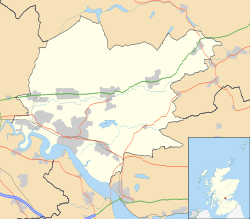 Muckhart Location within Clackmannanshire | |
| Population | 2,877 (Dollar area including Muckhart[1]) |
| OS grid reference | NO001007 |
| Council area | |
| Lieutenancy area | |
| Country | Scotland |
| Sovereign state | United Kingdom |
| Post town | Dollar |
| Postcode district | FK14 |
| Dialling code | 01259 |
| Police | Scotland |
| Fire | Scottish |
| Ambulance | Scottish |
| UK Parliament | |
| Scottish Parliament | |
Previously Muckhart, together with Glendevon, formed the southernmost tip of Perthshire. It was transferred to Clackmannanshire in a reorganisation of boundaries in 1971.
The parish boundary is somewhat eccentric and extends to the outer edge of Dollar, some three miles west. Due to this fact, the primary school is somewhat oddly located (the 1876 Act required the school to be at the centre of the parish) and lies over half a mile west of the outer edge of the main village. It is also some considerable distance from the main road. This can be explained in that it lies on the old coach road to Dollar. This is now just a dirt track to the school (locally known as the Cinder Path). West of the school the old coach route is very hard to follow.
The famed, historic Rumbling Bridge across Rumbling Bridge Gorge of the River Devon in Kinrosshire is about 300 metres south of the Muckhart Golf Course on the A823.
Pool of Muckhart
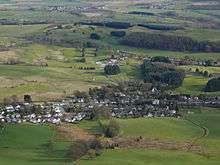
Pool of Muckhart (Scottish Gaelic: Poll Mhuc-àird) lies slightly east of the centre of the parish of Muckhart (see above). Pool of Muckhart lies in the strath of the River Devon, near the entrance to Glen Devon.
The village lies at the eastern end of the "Hillfoot towns" which skirt the southern edge of the Ochil Hills. The last in the range, standing as a backdrop to the village to its north side is "Seamab".
Of note in the village is the Muckhart Inn,[2] an early 18th-century coaching inn, lying at the point where the old coach road and modern road unite. Whilst the building was always low, this effect has been emphasised due to the raising of the road level (normal when ancient routes were macadamed in the early 19th century).
The war memorial,[3] on the western edge of the village by the main road, is by local sculptor George Henry Paulin, son of Muckhart's then minister, Rev Harry Paulin.

A church in Muckhart is mentioned as early as 1470, when its "rector" is listed as John Andrew under the Diocese of St Andrews Cathedral. The final pre-Reformation priest seems to have survived without replacement, John Sempill being in place from 1555 to 1570, being then replaced by Harry Colville, the first person termed "minister".[4] The ruins of this earlier church lie to the north-east of the current church.
The current parish church[5] also dates from the 18th century but is a plain Scots box chapel in style. In the churchyard is the family monument to the Christies of Cowden (a large estate one mile west, see below).[6]
This estate was famed for its Japanese garden which has now returned to nature, having been abandoned c.1960. Its Japanese gardener, Mat Su, is buried at the end of the Christie lair. The Japanese garden is now under renovation.[7]
Muckhart Golf Club
Muckhart Golf Club[8] lies on the School Road (Drumbum Road) south of the village. Set on a series of low rocky hills it includes several challenging holes. There are three nine-hole courses, named Arndean, Cowden, and Naemoor. The nine-hole Cowden course was opened by Miss Ella Christie, who provided 55 acres of land, on 28 May 1908. The course fell into disrepair during World War II, when it was used for the grazing of sheep. The course was restored after the war. A second nine-hole course, the Ardean course was added in the late 1960s on land leased from Colonel (later Sir) Robert Christie Stewart,[9] then Lord-Lieutenant of the county. A third nine-hole course named Naemoor was opened on 25 July 1998.
Yetts o' Muckhart

This hamlet lies around a quarter of a mile further east of Pool of Muckhart. A tollhouse was established here in the early 19th century on a road used by cattle drovers and coaches. Yett is a Scots word for "gate", also used in reference to hill passes.
For various reasons, the name of this hamlet causes some amusement. Its name comes up in several comedy programmes, supposedly used for "comic effect", notably Channel 4's production Absolutely.
Lees of Muckhart
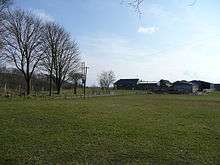
Not always recognised as the third and final part of the village group, this area is now in single use as a farm. It lies just west of the school on the old coach road.
Baldiesburn
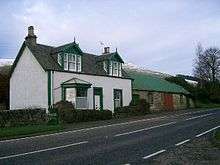
Somewhat depleted in size, this small hamlet on the main road west of the Pool of Muckhart now has only two houses. It has lost several buildings but was previously a small industrial centre. Of interest, the sheds still attaching the eastern building were built as a blacksmith's c. 1700. The building to the west was a carpenter's, but most of its sheds are now gone. The buildings on the south side of the road were removed when the main road was straightened c.1970. Also obliterated by this roadworks, the village curling pond stood some quarter of a mile further west.
Cowden estate
Early history
The Cowden estate lies just to the south of the higher ground known as the Ochil Hills,[6] on the main road (A91) just over a mile west of the Pool of Muckhart. The estate formerly focussed around Cowden Castle, a traditional Scottish stone-built castle of various dates, originating around 1500. This was demolished in 1950. Some of the early outbuildings, such as the sawmill range and bell-tower from the 17th century, still survive.
Archbishop Lambert built a house named "Castleton" on the property in 1320.[10] The Bruces of Clackmannanshire owned the estate from 1758.
John Christie era
John Christie FRSE (b. 4 July 1822, d. 19 August 1902) was the only son of Alexander Christie (born 1789, died 1859) and Isabella Robertson (b. about 1792) of Struan and the nephew of Mrs Isabella Christie (Hill). Alexander Christie was laird of Milnwood in Lanarkshire, where he operated three coal mines, .[11] and possessed of a considerable fortune from industry, which descended to John Christie. In addition, John Christie had two collieries in Edinburghshire.[12]
John Christie purchased Cowden (then known as Castleton), which contained about 524 acres,[13] in 1865. Mrs. Bruce sold the Cowden estate, a property of about 524 acres, which contained a large three-storey, rambling, sandstone house, to Mr. John Christie in 1866 who renamed the property "Cowden Castle".[6] Traditionally the estate focused upon woodland management and the raising of deer and pheasants. Cowden Castle became the seat of the Christie family. Mr. Christie later had a coat-of-arms created and placed over the entrance door. John Christie was reported to own 616 acres in 1873.[14]
Mr. Christie collected a wide variety of artefacts during his many trips to the European continent. He filled Cowden Castle with many unrelated objects, which resulted in a very eclectic style.[15]
John married Alison Philp (b. about 1817), daughter of Alison Coldwells and William Philp, of Stobsmills,[16] Midlothian (the home of her uncle John Coldwells) on 27 April 1859. John and Alison Philp Christie had three children. The first, a boy, John Coldwells Christie, (born 1860) died before he was twelve. Isabella (Ella) Robertson Christie was born 21 April 1861 at Millbank,[17] Cockpen, Edinburgh (John Christie's home near Edinburgh).[18] The third-born child was Alice Margaret Christie (b. about 1863). The girls' mother, Alison Philp Christie, was in poor health and Isabella Thornburn, an elderly woman, was their nurse. Later Miss Townsend served as the governess of the two teenage girls. John Christie believed that travel was the best education for girls so he took the girls on many trips to Europe.[19] Ella was taken to Paris at the age of twelve.[19]
Alice Christie married Robert King Stewart, KBE, of Murdostoun in 1881, when she was seventeen and left to live at Murdostoun Castle in Lanarkshire.[15] After Alice married, only Ella accompanied her father on trips.[19]
Mr Christie had an attack of pernicious anæmia about 1887. Although he recovered his health, his illness caused him to become difficult, secretive, and eccentric for the remainder of his life.[15][20]
In 1893 the castle was extended by the prodigious Glasgow architects Honeyman and Keppie,[21] probably at the request of Ella, given her father's health.
Mr Christie founded Christie Homes (later Lothian Homes Trust) in 1889, a charity which opened several orphanages for girls in and around East Lothian. A Christie Home was opened at Portobello in 1892. Tenterfield, in Haddington, was opened in 1898.[22] Mr Christie caused an orphanage to be created at Catlaw Head.[20] He concealed his support of orphanages from his family.[19]
Mrs Christie, who was a bit older than her husband, died in 1894 at the age of about 76.[15] Mr Christie refused to purchase a casket for his wife's burial, so Ella had to use her funds to purchase a casket for her mother.[19]
As Mr Christie's illness progressed he became increasing secretive and paranoid. In 1895, medical doctors advised Mr. Christie to take a trip to Egypt for health reasons. His daughter, Ella, as caretaker to her father, accompanied him on his trip. While in Egypt he suddenly decided to return home and abandoned his daughter in Egypt. When in his late seventies, Mr. Christie dyed his moustache and proposed marriage to a woman fifty years younger.[19]
Ella Christie found Mr. Christie dead at the age of 80 years in his townhouse at 19 Buckingham Terrace, Edinburgh on 19 August 1902. At the time of his death, he owned estates at Milnwood in Lanarkshire, Arndean[23] now in Perth and Kinross, Glenfarg and Easterton in Perthshire, and Carnbo in the county of Kinross, in addition to his estate at Cowden.[20]
Ella Christie era
The morning after John Christie died, a stranger arrived at 19 Buckingham Terrace and informed Miss Christie that her father had executed a will that left all his property to his orphanages and she and her sister were to get nothing. Miss Christie would have been homeless and penniless, however, Lady Stewart would have her husband on whom she could depend.[15]
Miss Christie resolved to contest the will. She was told by solicitors that the "dead hand would prevail", however, she eventually located a firm which would take her case.[15]
Miss Christie ordered a stained glass window erected in honour of her father removed from Muckhart Church and she moved to 19 Buckingham Terrace for the duration of the trial.[19]
The trial was held in the Law Courts in Parliament Square in July 1903.[15] Dr T. S. Clouston, president of the college of physicians and an expert in diseases of the brain, introduced medical evidence from the British Medical Journal[24] and gave his expert opinion that pernicious anæmia adversely affected the brain.[20] Several witnesses provided an abundance of testimony regarding Mr. Christie's bizarre behaviour in the years after his illness and the unfairness of the will. All of the evidence supported the conclusion that Mr. Christie was not of sound mind at the time of his execution of his will.[19]
This evidence put the defendants in a state of despair and persuaded them to agree to an out-of-court compromise settlement in which the Christie daughters received the bulk of the estate, while the orphanages received a sum sufficient for their needs. The press gave a value of £250,000 as the value of the estate – a vast sum in the years before the currency inflation of World War I.[19]
Miss Isabella (Ella) Robertson Christie (born 1861, died 1949), daughter of John (born 1822, died 1902) and Alison Philp Christie (died 1894),[15] famed for her foreign travels and accounts thereof.,[25] succeeded her father as laird of the Cowden Castle estate. She then preferred to be known as "Miss Christie of Cowden".[19] There were many times when Miss Christie was not in residence because of her extended travels abroad. Miss Christie travelled with a lady's maid and a bearer.
Miss Christie travelled in India, Ceylon, and Tibet in 1904,[19] She arrived first in Bombay where she was a guest of Lord and Lady Lamington, who provided her with a bungalow at Government House.[15] Miss Christie visited many places, both on and off the beaten path, while in India.
Miss Christie, like other lady travellers, preferred to maintain her independence, by avoiding travelling with a companion. When Miss Christie encountered Miss Jane Ellen Duncan on the plain of Ladakh, they pitched their tents as far apart as possible and agreed to travel on different days so as to avoid travelling together.[25] Nevertheless, Miss Christie and Miss Duncan were friends.
Miss Christie was a skilled photographer with the Kodak camera. She recorded her trips on film. She allowed Miss Duncan to use many of her photographs in her book about her travels.[26]
Miss Christie travelled in China and Japan in 1907.[18][19]
Cowden Castle received telephone service in 1910.[15]
Miss Christie travelled in Central Asia in 1910 and 1912.[18]
Miss Christie was elected a fellow of the Royal Scottish Geographical Society in 1911. She was elected Vice-President of the Society in 1934.[18] She was elected a fellow of the Royal Geographical Society in 1913.[19]
Miss Christie toured America with a side trip to Havana, Cuba in 1914. She sailed on the Carmania in February. While in New York City, she met the Vanderbilts, and lunched with Mrs. Franklin Roosevelt. In Washington, D. C., she toured the White House and Arlington, the former home of Robert E. Lee. In the South, she visited Richmond, Virginia and Charleston, South Carolina before leaving for Havana and Camagüey in Cuba. She then returned to the United States and visited New Orleans before moving on to Baton Rouge, where she was the guest of her second cousin, Miss Katherine Marion Hill (b. 25 December 1856, d. 25 February 1949) at her mansion on Lafayette Street, and met her American cousins, the descendants of John Hill. Moving west, she visited the Grand Canyon, Los Angeles, and Santa Barbara, California, where she met the widow of Robert Louis Stevenson. Starting back to the east, she stopped off at Yellowstone National Park before arriving in Chicago. After Chicago, she stopped at Niagara Falls, and then moved on to Massachusetts, where she visited Plymouth, a community of the Shakers, and the homes and graves of her favourite American authors. After a visit to Yale University, she returned to New York and went up to West Point on 22 June 1914 to attend the graduation of her Louisiana cousin, John Hill Carruth,[27] a cadet who fainted while on parade during her visit. Miss Christie returned home on the Mauretania in June 1914, just in time for the World War.[15]
Miss Christie did her part in the Great War. In 1916, she was offered the Directorship of a canteen in Bar-sur-Aube, France by the French Red Cross Committee, which she accepted. The canteen was called in French, Cantine des Dames Anglaises. She did this for a year and then returned to Cowden. In 1918, she once again went to France to direct a canteen at Mulhouse, Alsace until 1919, when the need for a canteen ended.[15]
Miss Christie published a book about her travels in central Asia, Through Khiva to Golden Samarkand,[28] in 1925.[29]
Miss Christie and her sister, Lady Alice Christie King Stewart, published a reminiscence of their lives entitled A Long Look at Life by Two Victorians[30] in 1940.[15] Miss Christie's sister died at Claghorn House in South Lanarkshire on 5 September of that same year.[31]
Miss Christie died of leucæmia in Edinburgh on 29 January 1949 at the age of 87 years.[15] Funeral services were held at Muckhart Parish Church[32] on Wednesday, 2 February. Miss Christie was the last surviving Christie. She is buried in the family plot, to the east of the church. The estate passed to her great-nephew, Colonel Stewart of Arndean.
Miss Christie's Japanese Garden
Miss Christie, after her visit to Japan in 1907, caused a Japanese garden, designed by Taki Handa,[33] a student at Doshisha University, Japan who was studying at Studley College, around 1908, to be planted at Cowden on a seven-acre site,[19] which she named Shah-rak-uenor, meaning place of 'pleasure and delight'.[19] Queen Mary visited the garden in 1932.[6] The garden was maintained by a Japanese man named Matsuo until his death in 1936, after which Miss Christie maintained the garden until her death in 1949. The garden then fell into disrepair and was closed permanently in 1955.[34]
Although the Japanese garden[35] is now unrecognisable, it still has many hundreds of rhododendrons, brought over from the Himalayas to brighten up the estate in the 19th century. There is now some interest in restoring the Japanese garden.[36] Funds are now being collected and work is underway to restore the garden.[37]
Recent history
Cowden Castle, burned in 1950 and was pulled down in 1952.[38] Much of the valuables from the house survived and were removed to Arndean. Many items of furniture were distributed among the many estate houses. Thereafter the estate was merged into the Arndean Estate, the seat of the Stewart family. (Ardean lies about a mile to the south-west of the Cowden estate.) Still surviving are Cowden's stables and the east and west lodges (the east lodge is now off the main road due to the straightening).[39] A faded dollar sign painted on a wall near the lodge marks a humorous direction sign to the town of Dollar to the west, but due to the road moving now serves no function.
Of great interest, the estate sawmill buildings still survive amid the woods. These date from the mid 18th century. They had adjacent ponds to float larger logs into the saws to cleverly avoid weight problems. Several modern houses have been built within the estate, many hidden in its wooded grounds.
Muckhart Mill

Slightly to the south-west of the Cowden estate, well off the current main road, lies Muckhart Mill at the confluence of Hole Burn, which powered the Mill, and the River Devon.[40] In more recent years this was connected to the Elmhirst family who were directly linked to the Elmhirsts of Dartington Hall, Devon, and to the Haggard family by marriage. Rider Haggard was the author of the infamous novel "She".
Records of Muckhart Mill date back to 16 October 1560 on a deed.[41] as witnessed by "Henry Douglas of Muckhart Mill" for Lady Margaret Douglas of Lochleven (née Lady Margaret Erskine), mistress of King James V of Scotland, widow of Sir Robert Douglas of Lochleven, mother of Sir William Douglas of Lochleven, to whose custody Queen Mary was committed in his castle at Lochleven on 17 June 1567.[41]
Later on, the Douglas family sold the mill to Bishop James Paton text[42] who subsequently passed ownership of the farm to Archibald Campbell, 5th Earl of Argyll in about 1571.
The Mill is category B listed and described as a "complex building of several dates: M.I.M. 1666, 1717, 1727 (internally) 1770 and 19th-century alterations, including ashlar facing of wheel-pit. Comprises three blocks at different angles, all pantiled, disused 20' overshot wheel at N., wooden arms, cast-iron outer frame. Workings and kiln gutted, renovated as children's holiday home 1967."[40]
It is believed to have one of Scotland's largest overshot waterwheels which was renovated into working condition by the current owner several years ago but is no longer in operation.
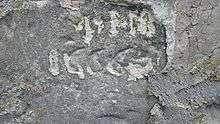
There is an inscription on the side wall of the Mill house "M.I.M. 1666" as identified by local postie and amateur historian, Alan Ritchie on 6/9/14.
Robert Burns
It is believed that Robert Burns would have passed by Muckhart Mill on 27 August 1787 while staying at Harvieston as recorded in his diary: "Monday.—Go to Harvieston. Go to see Caudron Linn, and Rumbling Brig, and Deil’s Mill Return in the evening."[43]
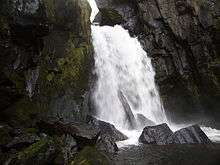
While staying at Harviestoun Burns wrote two poems, "The Banks of the Devon" and "Fairest Maid on Devon Bank".[44] Burns fell for the charm and beauty of Charlotte Hamilton but she was more attracted to Burns' friend, Adair whom she later married.
Muckhart Mill Farmhouse

Adjacent to the mill lies Muckhart Mill Farmhouse, a category B listed property described as a house of "single-storey and attic with swept dormers dated (17)80; later wooden porch: steading single-storey, partly with loft, pantiled and white-washed".[45]
Muckhart Mill was a children's holiday home and the owners often get visitors who used to stay here over the summer, riding ponies and swimming in the river.
YouTube has some old film footage from the 1960s of the Forth Valley Pony club and other clips which contain shots of The Mill.[46][47]
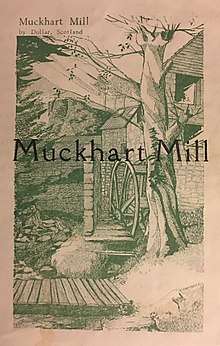

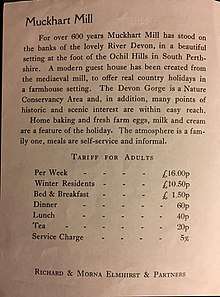
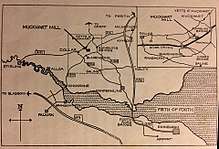
Muckhart Mill Lime Kiln
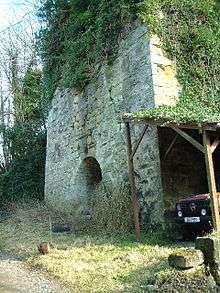
Further up the farm track lies a category B listed Limekiln. Described as "Mid 19th century. Very large, about 35' high, square plan, stone-built with battered walls, three arched fireholes; operated by the Carron Company."[48] The Carron Company was at the forefront of the Industrial Revolution in the United Kingdom and who built the Carron iron Works in 1759 that Burns attempted to visit on "Sunday, August 26.—Camelon, the ancient metropolis of the Picts, now a small village in the neighbourhood of Falkirk. Cross the Grand Canal to Carron." He attempted to visit the iron works but, being a Sunday, was refused entrance. Both travellers instead withdrew to the Carron Inn opposite. They dined on the second floor of the Inn and Burns later recorded the event briefly in his journal of the tour—Carron-breakfast. However, he also vented his anger, by scoring a few lines of prose on one of the Inn's windows. He used a diamond-tipped stylus which had earlier been presented to him in Edinburgh by James Cunningham, 14th Earl of Glencairn:
At Carron Ironworks
We cam na here to view your warks,
In hopes to be mair wise,
But only, lest we gang to hell,
It may be nae surprise:
But when we tirl'd at your door
Your porter dought na hear us;
Sae may, shou'd we to Hell's yetts come,
Your billy Satan sair us! [49]
The Mill is listed as "Blairbane" in the 1st edition of the OS 6-inch map (Fife and Kinross 1855, sheet xxi [50]
Vicar's Bridge
In the same locale lies Vicar's Bridge. Sadly the historic bridge was replaced by a modern structure in the 1960s. Of note here, was a murder in the late 19th century of a passer-by a certain Joe Bell. A tree known as "Joe Bell's tree" had the letters JB carved on it and allegedly were carved whilst he waited for a victim. This could of course have been added after the event for dramatic purposes. Joe Bell had the unfortunate claim to fame of being the last man publicly hanged in Scotland (in Perth) on 22 March 1868.[51]
Back on the main road to Dollar the small farm known as Shelterhall was bought in a derelict state by the Longmuir brothers of Bay City Rollers fame in the late 1970s and temporarily became a place of "pilgrimage" for some years during the period of "Rollermania", which was rife at that time. Alan Longmuir owned and ran the "Castle Campbell Hotel" in Dollar to the west.
Public rights-of-way
The Clackmannanshire Council has proposed the creation of public rights-of-way in the Muckhart area including the ancient coach road section known as the Cinder Path.[52]
Notable residents of Muckhart
- Dr Grace Cadell (1855–1918), militant suffragette and Scotland's first female surgeon; lived her final years at Mosspark, Yetts of Muckhart
- Isabella (Ella) Robertson Christie[53] (1861–1949), Victorian lady traveller
- John Christie (1822–1902), landowner
- Sholto Johnstone Douglas (1871–1958), artist
- Rev Adam Gib (1714–1788)
- George Alexander Gibson (1854–1913), physician, medical author and amateur geologist, Fellow of the Royal Society of Edinburgh, Chief Physician at Edinburgh Royal Infirmary
- Alexander Izat and his son, James Rennie Izat, railway engineers in India
- George Henry Paulin (1888–1962), sculptor and artist
Ministers of Muckhart
- Rev John Govan (1660s)
- Rev James Thomson of Ormiston (1800-1871) minister of the parish from 1832. Left the established church in the Disruption of 1843 and became minister of the Free Church of Dollar and Muckhart (sited in Dollar).[54]
- Rev Alexander M. Ferguson minister from 1843 to 1869.
- Rev George Paulin 1880s
See also
- River Devon, Clackmannanshire
- Rights of way in Scotland
- List of listed buildings in Muckhart, Clackmannanshire
References
- Census 2001
- "Muckhart Inn". theinnatmuckhart.com. Retrieved 9 April 2018.
- "Muckhart War Memorial". clacksweb.org.uk. Retrieved 9 April 2018.
- "Full text of "Fasti ecclesiæ scoticanæ; the succession of ministers in the Church of Scotland from the reformation"". archive.org. Retrieved 9 April 2018.
- "Sacred Scotland - Scotland's Churches Scheme – Muckhart Parish Church". sacredscotland.org.uk. Retrieved 9 April 2018.
- The Ochil Landscape Partnership Landscape Strategy Archived 14 July 2011 at the Wayback Machine. April 2008.
- "The Japanese Garden: A Restoration Appeal" (PDF). www.fineartcommissions.com. 2015. Retrieved 26 October 2015.
- "Muckhart Golf Club – Perth and Kinross, FK". muckhartgolf.com. Retrieved 9 April 2018.
- "Colonel (later Sir) Robert Christie Stewart". thepeerage.com. Retrieved 9 April 2018.
- Cowden Castle. In: Scotland's Places.
- "Collieries in Scotland - 1860". www.scottishmining.co.uk. Retrieved 25 October 2015.
- "List of Collieries In Scotland 1854". scottishmining.co.uk. Retrieved 9 April 2018.
- Fletcher, Angus. Inland Revenue. Edinburgh: HMSO. Scotland: owners of lands and heritages 17 & 18 Vict. Cap. 91, 1872-1873, 1874: p. 124.
- Scotland: Owners of Land and Heritages 1872–1873. Edinburgh: Murray and Gibb, Printers to Her Majesty's Stationery Office, 1874: p. 112.
- Stewart, Averill. Alicella. London: John Murray, 1955.
- Good Stuff. "Gorebridge, Stobsmills House, Walled Garden, Borthwick, Midlothian". britishlistedbuildings.co.uk. Retrieved 9 April 2018.
- Good Stuff. "Millbank House, Including Ancillary Structures, Walled Garden, Gates, Gatepiers and Boundary Walls, Cockpen, Midlothian". britishlistedbuildings.co.uk. Retrieved 9 April 2018.
- Christie, Ella R. Khiva to Samarkind. Coventry: Trotamundas Press, 2009 ISBN 978-1-906393-17-5.
- "Birkett, Dea. Spinsters Abroad. The History Press, 2004" (PDF). Archived from the original (PDF) on 25 March 2012. Retrieved 16 September 2011.
- The Will of John Christie of Cowden. The Scotsman, Edinburgh, Tuesday, 21 July 1903, p. 8.
- "DSA Building/Design Report". scottisharchitects.org.uk. Retrieved 9 April 2018.
- Florabank Road, Templedean House and West Templedean Including Boundary Walls and Gatepiers, Haddington, British Listed Buildings.
- "Arndean Estate Powmill". Archived from the original on 18 May 2008. Retrieved 9 April 2018.
- Robertson WF. Sixty-Ninth Annual Meeting of the British Medical Association, Section on Psychological Medicine. A discussion of the role of toxic action in the pathogenesis of insanity. Br Med J. 1901;2(2130):1229–1266. doi:10.1136/bmj.2.2130.1229. PMC 2507358.
- Middleton, Dorothy. Victorian Lady Travellers. New York: E. P. Dutton & Co., Inc., 1965, p. 10.
- Duncan, Jane Ellen. Summer Travels Through Western Tibet. London: Smith, Elder & Co., 1906.
- Cullum, G.W.; Holden, E.S.; Braden, C.; Robinson, W. (1920). Biographical Register of the Officers and Graduates of the U.S. Military Academy at West Point, N.Y.: 1-6810. Houghton, Mifflin. p. 1674. Retrieved 9 April 2018.
- Through Khiva to Golden Samarkand
- Miss Christie's book has been reprinted by Trotamundas Press, Ltd; Coventry CV1 2FL, UK in 2009. ISBN 978-1-906393-17-5.
- A Long Look at Life, by Two Victorians
- Glasgow Herald, 6 September 1940, p. 7.
- "Muckhart Parish Church". muckhartparishchurch.co.uk. Retrieved 9 April 2018.
- "taki handa 半田多喜 | Jason Nolan". Flickr. 23 June 2011. Retrieved 9 April 2018.
- The Scottish Gardens.
- "Flickr – Japanese garden". flickr.com. 8 June 2011. Retrieved 9 April 2018.
- Cowden Japanese Garden Archived 16 July 2011 at the Wayback Machine, Dollar, Clackmannanshire. The Garden History Society, August 2009.
- "2The Japanese Garden" (PDF). www.fineartcommissions.com. Fine Art Commission. 2015. Retrieved 25 October 2015.
- Gazetteer for Scotland. Cowden Castle, 2010.
- Ardmill, Formerly Cowden Castle E. Lodge, Muckhart, British Listed Buildings.
- Historic Environment Scotland. "Muckhart Mill (Category B) (LB15249)". Retrieved 25 March 2019.
- "Notes on a Deed by Lady Margaret Douglas". Electric Scotland. Retrieved 2 July 2012.
- "Full text of "Caledonia; or, A historical and topographical account of North Britain, from the most ancient to the present times with a dictionary of places chorographical & philological"". archive.org. Retrieved 9 April 2018.
- "Title". The Life of Robert Burns Burns in the South, West and North.
- "Robert Burns and his connection to Tillicoultry". Burns poems. Archived from the original on 21 August 2008. Retrieved 2 July 2012.
- Historic Environment Scotland. "Muckhart Mill, House and Steading (Category B) (LB15250)". Retrieved 25 March 2019.
- Peirs video of MMFH on Youtube
- Cameron video on youtube
- Historic Environment Scotland. "Muckhart Mill, Limekiln (Category B) (LB15251)". Retrieved 25 March 2019.
- "Robert Burns and Carron". Falkirk Local History Society. Retrieved 2 July 2012.
- "Muckart Mill". RCAHMS. Retrieved 23 December 2014.
- "Timeline of Capital Punishment". Capital Punishment UK.
- Map 8: Muckhart and Surrounding Area. Clackmannanshire Council, 2007.
- Isabella (Ella) Robertson Christie
- Ewing, William Annals of the Free Church
Further reading
- Christie, Ella R. Khiva to Samarkand. Coventry: Trotamundas Press, Ltd., 2009 ISBN 978-1-906393-17-5 (Reprint of Christie, Ella. Through Khiva to Golden Samarkand. London: Seeley, Service & Co. Ltd., 1925)
- Christie, Ella R. & Stewart, Alice Margaret Christie King. A Long Look at Life, by Two Victorians. London: Seeley, Service & Co. Ltd., 1940.
- Stewart, Averil. Alicella. London: John Murray, 1955.
- Birkett, Dea. Spinsters Abroad: Victorian Lady Explorers. New York: Dorset Press, 2001. ISBN 0-7607-1932-2.
- Day, John Percival. Clackmannan and Kinross. Nabu Press, 2010 (Reproduction of a book published before 1925).
- Barbieri, M. A Descriptive and Historical Gazetteer of the Counties of Fife, Kinross and Clackmannan: With Anecdotes, Narratives and Graphic Sketches, Moral, Political, Commercial and Agricultural. Nabu Press, 2010.
External links
| Wikimedia Commons has media related to Muckhart. |
- Clackmannanshire Council - Population Breakdown by Ward 2003
- Google Maps - Muckhart
- ClacksNet - Clackmannanshire's Community Network
- Muckhart - Visit Scotland